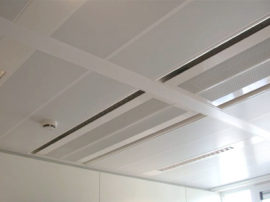
The “chilled beam” system is one of the latest innovations to make its way to the North American market. Active Chilled Beams have been popular in Europe and Australia for more than a decade. The system involves placing cooling coils at the ceiling level to cool the rising warm air. The cooled air then gently descends to the occupant level, providing a pleasant cooling effect with minimal air movement.
Mechanical engineers in Europe start with chilled beams as the baseline system, much like we start with VAV systems as the baseline here in North America. This technology has started to capture the interest of many consultants because of potential energy reductions of 20-50%, depending on the type of system, climate, and building. Not to mention a further 20-40% reduction ductwork sizing, air-handling units, exhaust fans, chillers, and boilers to help offset the cost of the chilled beam units and infrastructure.
The operation of the system is quite simple … Primary air (100% outside air) is dehumidified to between 50-57°F dew point and used to control the latent requirements of the space, provide fresh air to the occupants, and pressurize the beam plenum. The primary air then passes through an array of formed nozzles along the length of the beam. The jets of air discharging from the nozzles cause room air (secondary air) to be drawn through the unit mounted coil via induction. The coil is serviced by chilled water which is maintained at 2-8°F above dew point of the primary air. The localized recirculation of room air provides substantial sensible cooling to the space at exceptionally low acoustic signatures (NC18-NC26). As a result of the reduction in total fan power, and higher chilled water operating temperatures, the building HVAC operating cost can be reduced by as much as 50% compared to “all-air” systems.
A) 1” (25mm) standing duct collar for primary air. Duct run-out serving unit is sized to limit air velocity ≤ 600 fpm. Balance of system duct work sized traditionally.
B) Primary air plenum (100% outside air)
C) Secondary air (room air)
D) Unit mounted coil. (Two and/or four pipe available. Typical chilled water: 55-6°F, hot water: 85-115°F)
E) Mixed air. (Induction ratio range = 3:1 – 6:1 depending on the nozzle selection and plenum pressure)
F) Discharge air (Typical Cooling: 63-66°F, Heating: 75-85°F)
G) Adjustable mounting brackets. Unit quickly attaches to building structure via aircraft cable or threaded rod
Due to the highly localized mixing within the beam, the temperature variations observed by the occupants are less than half of what would be expected with traditional air delivery systems. As a result, comfort levels are improved, and occupant complaints are minimized.
Twa MAC Beams are available in three basic sizes which are designed to fit within a standard 2’ wide T-bar ceiling grid, and can also be installed within a finished drywall ceiling (2’x4’, 2’x6’, 2’x8’). Each module can be equipped with optional coil lengths, circuits, and indiction nozzles, to suit the heating , ventilation, and air conditioning requirements of the space.
Some of its advantages and benefits include:
-
Lower maintenance. Chilled beams have no filters to change and there are no moving parts, filters or fans, high life expectancy.
-
Simple on-site co-ordination and installation.
-
Ideal for new construction and retrofit applications.
-
Building heights can be lower with the use of an active chilled beam leading to a reduction construction costs or allow additional floors to be constructed.
-
Lower operating costs – chilled beams use water for cooling and take advantage of free cooling, which saves energy (20-50% energy cost savings).
-
Double the COP of the cooling plant
-
High indoor air quality – air is reused locally, so there’s no contaminant mixing
-
Controlled comfort – no drafts, even cooling, and more comfortable cooling temperatures maintained.
-
Obtain credits for LEED certification for both energy and innovation.
Available Downloads
For additional information: [email protected]

